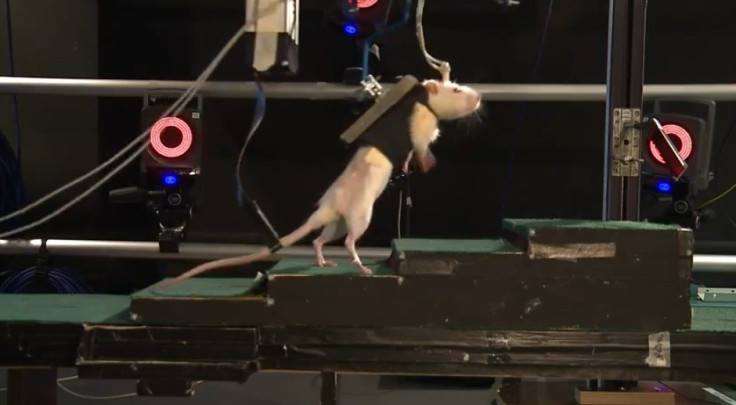Paralysed Rats Walk Again Following Treatment, Giving Hope to Humans [Video]

Scientists have developed a method to help paralysed rats learn to walk again, raising hope that a similar technique could be developed for paralysed humans.
Swiss scientists were able to help the rats walk again through a combination of spinal cord stimulation and robotic-aided therapy.
The study, at the International Paraplegic Foundation in Spinal Cord Repair at the Ecole Polytechnique Federale de Lausanne (EPFL) in Switzerland, said the key to the success was that the treatment allowed the rats to walk voluntarily.
The scientists injected chemicals directly into the spinal cord of the paralysed rats, mimicking the signals the brain would normally send to initiate movement in the limbs, and stimulated the nerves with electrical impulses.
The rats were hoisted into a two-legged standing position with a robotic harness that did not propel them forward, but stabilised them so they could attempt to walk without falling.
The rats showed a massive three-fold increase in the connections between the brain and spinal cord after training, according to the research.
Grégoire Courtine, chair of EPFL, explained: "This is the world cup of neurorehabilitation.
"Our rats have become athletes when just weeks before they were completely paralysed. I am talking about 100 percent recuperation of voluntary movement.
"After a couple of weeks of neurorehabilitation with a combination of a robotic harness and electrical-chemical stimulation, our rats are not only voluntarily initiating a walking gait, but they are soon sprinting, climbing up stairs and avoiding obstacles when stimulated."
"We had a very high percentage of success with these animals. We always observed, in all of the animals we treated, recovery of voluntary movement," Courtine said.
More than 100 lab rats were tested, with varying rates of success. "In some animals it was weak. In some animals it was spectacular," he added.
While they understand human spinal injuries differ greatly from those of rats, the scientists are hoping to launch a similar project with the goal of designing a fully operative spinal neuroprosthetic system for implanting into humans.
"We are not thinking this will cure spinal cord injury. We need to be very clear on this. This is not a cure," Courtine stressed.
"What we observed in rats -- the plasticity and the extent of the recovery is very surprising -- so now we need to optimise all these systems for humans and do our best to at least improve functional recovery."
© Copyright IBTimes 2025. All rights reserved.






















